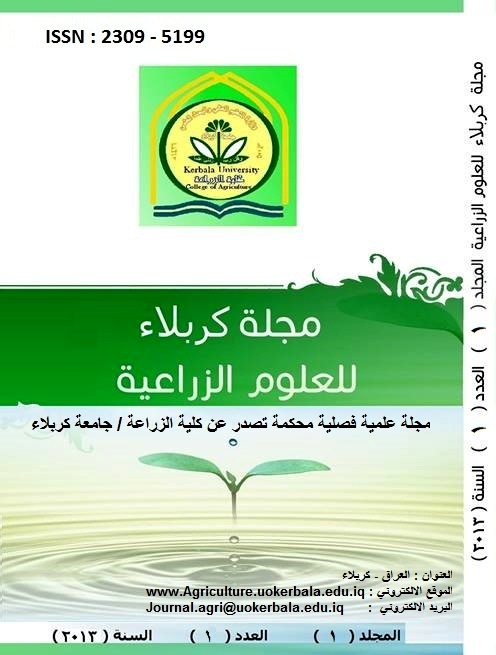Use of Pollen Supplements and Substitutes in Feeding of Honey Bee colonies, Apis mellifera L. During Summer Season
DOI:
https://doi.org/10.59658/jkas.v1i1.339Keywords:
Honey bees, Pollen Supplements and AlternativesAbstract
Abstract
The study aimed to find out the efficiency of protein mixtures used as supplements and alternatives to pollen on the activity of honey bee colonies in Hartha / Basra for the period from 15/5/2011 until 30/7/2011 The mixtures are: a mixture of pollen count with milk powder, lentil mixture and yeast bread, lentils and mix egg whites, mix lentils and mushrooms, paste nictapol commercial and mixed pollen papyrus.
The results showed the highest area of the brood sealed when mixed pollen with milk sorting reaching 12124.4 cm 2, followed by treatment of pulp Alnictapol, which amounted to an area of 11,650 cm 2 and a difference of legal entity from the rest of the transaction, and the smallest area was when Mix pollen papyrus, amounting to 8958 cm 2.
For pollen mixture showed higher paste Alnictapol area was 1236.3 cm 2 and less space when you mix the pollen grains of papyrus, which amounted to 904.1 cm 2, as there have been no significant differences between all the transactions in the area of pollen.
At the level of honey production has the highest weight was 4100 g when mixed with milk, pollen count and significant difference from the rest of the transaction, and the smallest weight of the mixture when the pollen and the papyrus of 2889 g.
The results of food preference than transactions with the pollen count milk powder as well as a paste Alnictapol trade reaching 100% in each treatment were mixed lentil and mushroom less favorable than the rest of the transaction amounted to 72.5%.
Also given transaction mix pollen with milk screening dried, a paste nictapol commercial correlated significantly with the production of brood sealed and pollen and the amount of honey, and for the treatment of mixed lentils, yeast bread was their link moral with the production of brood and honey, as he was positive with the rest of the transactions at all levels of production of brood sealed and the amount of pollen and honey.
The analysis of the basic components of the pollen collected by worker honey bees from protein and fats and sugars, ash and moisture percentages were 18.32%, 3.136%, 33.633%, 0.960%, 43.95%, respectively
Downloads
Published
How to Cite
Issue
Section
License
Copyright (c) 2013 Journal of Kerbala for Agricultural Sciences

This work is licensed under a Creative Commons Attribution 4.0 International License.
Licensing Terms
All articles are published under a Creative Commons License and will be directed to the Creative Commons Attribution 4.0 International License That permits use, distribution, and reproduction in any medium, provided the original work is properly cited and is not used for commercial purposes.
Use by non-commercial users
For non-commercial and non-promotional purposes individual users may access, download, copy, display, and redistribute the articles to colleagues, as well as adapt, translate, text- and data-mine the content subject to the following conditions:
- The author's moral rights are not compromised. These rights include the right of "paternity" (also known as "attribution" - the right for the author to be identified as such) and "integrity" (the right for the author not to have the work altered in such a way that the author's reputation, or integrity may be impugned).
- Where content in the article is identified as belonging to a third party, it is the obligation of the user to ensure that any reuse complies with the copyright policies of the owner of that content.
- If article content is copied, downloaded, or otherwise reused for non-commercial research and education purposes, a link to the appropriate bibliographic citation (authors, journal, article title, volume, issue, page numbers, DOI, and the link to the definitive published version on JKAS website) should be maintained.
- Copyright notices and disclaimers must not be deleted.
- Any translations, for which a prior translation agreement with JKAS has not been agreed, must prominently display the statement: "This is an unofficial translation of an article that appeared in an FSP publication. The publisher has not endorsed this translation."
Use by commercial "for-profit" organizations
Use of JKAS Open Access articles for commercial, promotional, or marketing purposes requires further explicit permission from JKAS (journal.agri@uokerbala.edu.iq) and will be subject to a fee.
The commercial purposes include:
Copying or downloading of articles, or linking to such articles for further redistribution, sale, or licensing; Copying, downloading, or posting by a site or service that incorporates advertising with such content; The inclusion, or incorporation of article content in other works, or services (other than normal quotations with an appropriate citation) that is then available for sale or licensing, for a fee (for example, a compilation produced for marketing purposes, inclusion in a sales pack); Use of article content (other than normal quotations with appropriate citation) by for-profit organizations for promotional purposes; Linking to article content in e-mails redistributed for promotional, marketing or educational purposes; Use for the purposes of monetary reward by means of sale, resale, license, loan, transfer or other form of commercial exploitation such as marketing products; Print reprints of articles can be purchased from journal.agri@uokerbala.edu.iq.
Permissions
- No special permission is required to reuse all, or part of the article published by JKAS, including figures and tables for non-commercial purposes.
- Any part of the article may be reused, for non-commercial purposes, without permission provided that the original article is cited.
- Reuse of an article does not imply endorsement by the authors, JKAS

